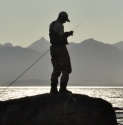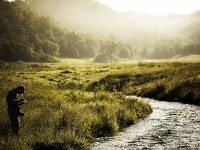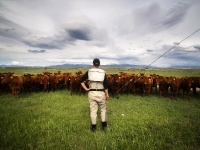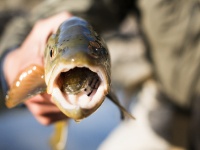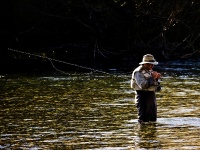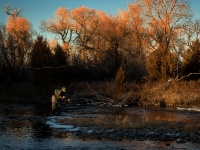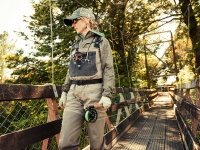Fd: How’s your life these days in Montana? What spots do you fish?
Ben Pierce: Life in Montana is great. I grew up on a small dairy farm in central Massachusetts and headed west when I was 18 years old. My grandfather taught me to fly fish for small brook trout around the family farm, but I longed to cast for wild cutthroat in the high country. I remember looking at a photograph in the back pages of Field & Stream Magazine as a young man. It was an image of a trout fisherman casting on a mountain lake in the Absaroka-Beartooth Wilderness, which straddles the boundary between Montana and Yellowstone National Park. I couldn’t fathom the image – those high rocky peaks, that perfect cast. It seemed so foreign to believe that place was my country, that I could go there and experience that place and be that person.After high school, I laid $60 down on the counter and bought a ticket west. I spent three-and-a-half days in a Greyhound bus travelling across the United States to the mountains of Montana. I’ll never forget rounding a bend on the highway and that first sight of the Crazy Mountains rising above the prairie.I spent six years at Montana State University – fishing nearly all of that time – and graduated with a degree in English Literature. I work primarily as a journalist for the local newspaper in Bozeman, where I am the Outdoors Editor. I write about fishing, camping, biking – everything outdoors – and shoot photographs to accompany those features. This Friday I’m leaving for a backpacking trip into the Bob Marshall Wilderness with my girlfriend Christine. “The Bob” is the second largest wilderness area in the lower 48. We’ll hike 60 miles through the mountains to fish for native westslope cutthroat trout and bull trout. The big ponderosa pines, clear creeks and wild fish make every step of the way memorable. We hiked into “The Bob” in 2012 and fell in love with the area. I’m really excited to go back.
Fd: What are your main influences regarding photography?
Ben Pierce: I don’t think I draw a lot of influence from photography, but I do spend a lot of time looking at paintings, reading and watching films. When I studied at Montana State University, I had a professor named Greg Keeler. He taught upper level English classes. He was admittedly, and proudly, a bit of an odd ball. I loved his classes because he taught in an unconventional fashion and he gave me good grades. He was always pushing place and I think that really resonated with me. He spoke about the land as a character, as an overarching element and influence in all we do. I think those classes shaped the way I think about my work today. I certainly view the land as a character in nearly all of my writing, and my photography too. My human subjects are often secondary to the landscape, but only so much as necessary to depict the influence of place. When I think about why I view paintings and films, and why I read, it is in pursuit of a feeling, a sense of place, or an emotion, and it doesn’t matter much to me what the subject is. As a photographer, my primary motivation is to capture the essence of place, to depict what it feels like to be here, in Montana.
Fd: What would you recommend to the starting photographer and to the anglers that want to get better pictures of their fishing trips and catches?
Ben Pierce: I would recommend putting the camera away. Fly-fishing takes us to beautiful places and it can be tempting to want to document everything, but I think it is important to let yourself experience those moments and wait for the photographs to come in their own time. I often struggle as a photographer with the double-edged nature of the medium. At once you are capturing a scene and telling a story, but on the flipside you are removing yourself from the moment. What good is it to see your friend catch a wild fish if you are so caught up in your aperture and shutter speed that you cannot appreciate the beauty before you? I believe that there are things in life that pair well and things that don’t. Fly-fishing, for me, is an activity that does not lend itself to distraction. I have found success in letting go of the desire to make photographs. I pick a few moments throughout the day when I give myself over to photography. I wait for those times when I feel I can capture what it means to be in a place, that elemental aesthetic. If it’s not there, the camera stays in my pack.
Fd: How was the New Zealand experience?
Ben Pierce: New Zealand was exceptional, and hardly because of the fishing. I once worked at a wader factory for a well-known company here in Bozeman. The job paid well and it bought me a plane ticket to New Zealand in 2003. I spent five months on the South Island, carrying a fly rod through miles of bush, and rarely casting. I was consumed with fishing when I arrived, but it soon fell to the wayside. I became more interested in meeting new people and seeing the country. My first date with Christine was a fishing trip to the Madison River. We drove a dirt road up Bear Trap Canyon and picked a pullout where trout were known to rise. We caught a few small browns on dry flies and then sat on a log and watched the sun set over the river. She made me happy, and I knew then I wanted her to see New Zealand. We spent about a month on the South Island, fruitlessly chasing trout on well-known rivers a good portion of that time. Then we met Jack Kos. Jack lives in Christchurch and became a fast friend. We backpacked together into one of the South Island’s forgotten valleys. Our first dinner together was memorable. Christine and I set up our camp stove in the hut and grabbed a couple of packets of Ramen noodles to cook for dinner. We were ravenous after a 10-kilometer hike through the bush. Jack proceeded to set his stove on the counter next to ours. To our astonishment, Jack produced a pair of lamb chops for dinner. In the Montana heat, we’d never get away with packing fresh meat into the mountains. But this was New Zealand, and the smell filling the hut was intoxicating. Jack told us he’d given up eating poorly in the bush. It was a turning point. The rest of the trip we ate as many green-lipped mussels and lamb chops as we could find. Jack’s a bit of a beer connoisseur, and we’d pack several bottles of Montana microbrew across the Pacific and into the bush to share with him. I’ll never forget the smile on his face as he ate those lamb chops and drank that beer. The next day, Christine hooked into the biggest brown trout she’d ever caught in a pool we’d nearly passed up due to the presence of a downed beech tree in the tail out. She swam around that tree to land the fish – a six-and-a-half-pound brute every bit the fish we’d come for.It was great to have success on the water, but it was better to make a new friend.
Fd: Any project or trip ahead?Ben Pierce: The Bob Marshall Wilderness is a three-hour drive from this computer screen. I better get gone…
More about Ben Pierce's work at: benpiercephoto.com

